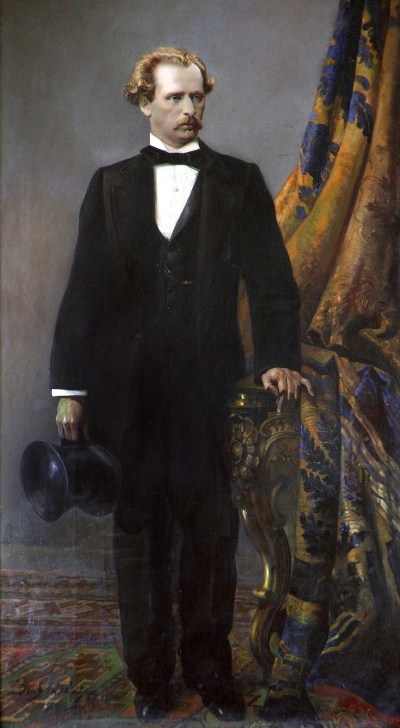

Portrait by V. N. Yakovlev, 1946
Nikolay Grigor’yevich Rubinstein (1835–1881) was a Russian pianist, conductor and public figure of the second half of the 19th century, the younger brother of composer Anton Grigor’yevich Rubinstein (1829-1894). All of the musical lessons he had taken were during his childhood, prior to the age of 13. He studied piano with Theodor Kullak and harmony and counterpoint with Siegfried Dehn in Berlin, and also piano with Alexandre Villoing in Moscow. His subsequent success was entirely the result of his own musical efforts. He began giving private lessons to students at the age of 14. In 1885 he graduated from the Law Department of the Moscow University.
Nikolay Rubinstein gave concerts mainly in Moscow. An exception to this was formed by his triumphant performances as a pianist and conductor at the concerts of the World Fair in Paris in 1878. At the age of 24 he became a generally acknowledged musical leader in Moscow. He gave the Russian premiere performances of a number of compositions by Robert Schumann, Frederic Chopin and Franz Liszt – the latter considered the pianist to be the best performer of his “Totentanz” and dedicated to him his Fantasy on the Themes of Beethoven’s “Ruins of Athens.” Rubinstein was a great promoter of Russian music – the works of Mily Balakirev (who dedicated the piano fantasy “Islamey” to him) and especially Pyotr Tchaikovsky (the composer dedicated to him his two Piano Pieces opus 1, the song “So What Shall Come of It?”, the Second Piano Concerto, the First Symphony (“Winter Reveries”) and, following Nikolay Rubinstein’s death – his piano trio “In Memory of a Great Artist).
From 1860 and until the end of his life Nikolay Rubinstein was the artistic director and conductor at the concerts organized by the Russian Musical Society (RMS) in Moscow.
Together with playwright Aleksandr Ostrovsky, actor from the Maly Theater Prov Mikhaylovich Sadovsky and a few other people, and with the assistance of Prince Vladimir Feodorovich Odoyevsky, in 1865 he funded in Moscow the Artistic Circle, which united the artistic elite of the city.
In 1859 he became the initiator of the establishment of the Russian Musical Society in Moscow (later to become the Moscow Branch of the RMS and from 1873 – the Imperial Russian Musical Society or IRMS), became its leader and set up music courses as part of it, which were subsequently transformed into the Moscow Conservatory. Having become the first director of the Conservatory (the post of which held up to his death in 1881), he assembled a unique group of professors, having invited into the Conservatory the most qualified musicians – performers, composers and music theorists, among which were Nikolay Albertovich Hubert, Karl Klindworth, Ferdinand Laub, Pyotr Il’ich Tchaikovsky, Sergey Ivanovich Taneyev, Prince Vladimir Feodorovich Odoyevsky, Karl Albrecht, Nikolay Dmitrievich Kashkin and many others. He fulfilled Odoyevsky’s initiative by establishing within the Conservatory the Department of History of Early Russian Church Singing, the only one of its kind in Russia, directed by Archpriest Dimitry (D.V.) Razumovsky. He built a library and a museum in the Conservatory, the latter being a collection of musical instruments and acoustic devices. He himself was a talented teacher, a professor of piano, and his students included Sergey Taneyev (who dedicated his cantata “Ioann Damaskin” to the memory of his teacher), Aleksandr Siloti and Emil Sauer. In 1912 the Nikolay Rubinstein Museum was opened on money donated by friends and enthusiasts (which was restored at the Moscow Conservatory as the Nikolay Grigor’yevich Rubinstein Museum).